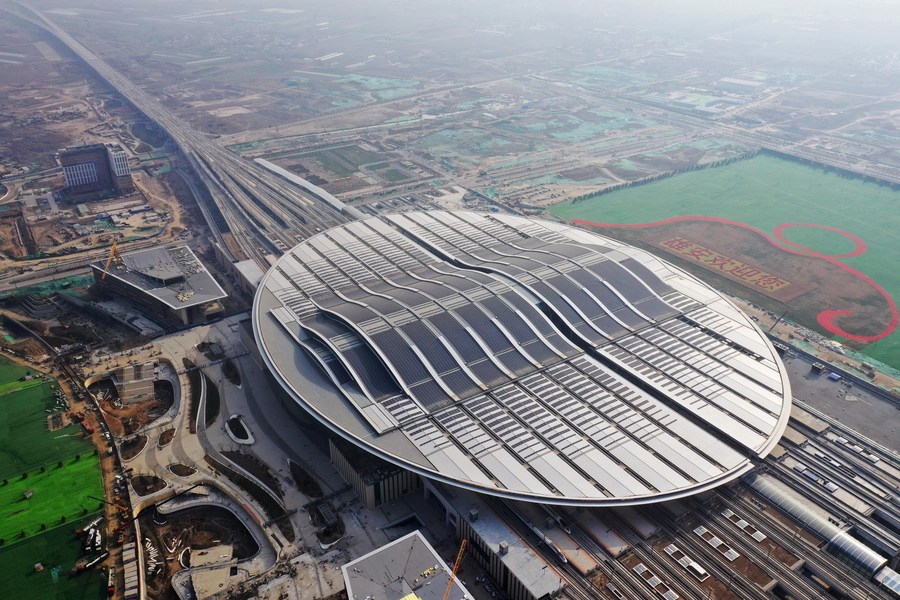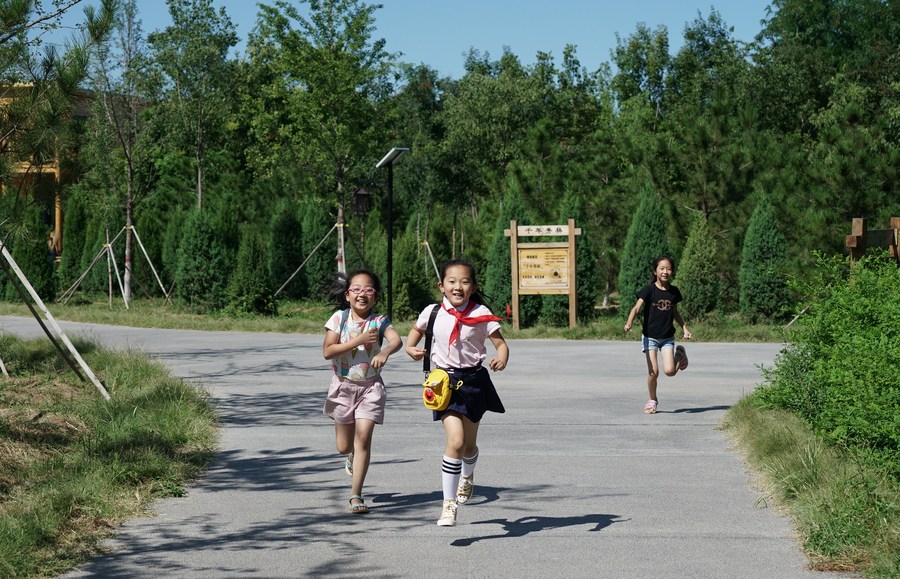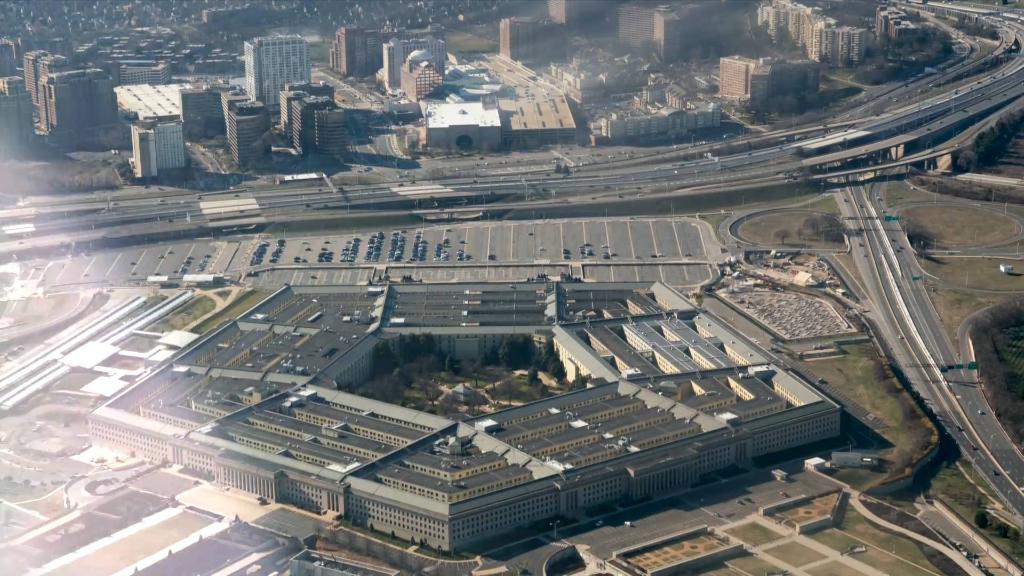* Dubbed China's youngest city and a "city of the future," Xiong'an New Area marks its fifth anniversary.
* Major roads to the city, the main streets in the city, the Ecological Corridor, and the urban water system have taken shape.
* Travel time from Beijing West Railway Station to Xiong'an was cut from one and a half hours to about 50 minutes.
SHIJIAZHUANG, March 31 (Xinhua) -- Chen Lixin, a digital intelligence innovation manager with China Mobile, has worked in Xiong'an for over three years, witnessing the city from a blueprint to reality.
Dubbed China's youngest city and a "city of the future," Xiong'an New Area marks its fifth anniversary on Friday.
China announced plans to establish Xiong'an New Area on April 1, 2017, to relieve Beijing of functions non-essential to its role as the national capital and advance the coordinated development of the Beijing-Tianjin-Hebei region.
Xiong'an in north China's Hebei Province is about 100 km away from Beijing.

Staff members work at the intelligent operations center in Rongdong District of Xiong'an New Area, north China's Hebei Province, March 29, 2022. (Xinhua/Zhu Xudong)
Over the past few years, Chen's team started with only a dozen to more than 400 people, over 90 percent of whom come from Beijing.
"We are building a smart city operation and management platform dubbed "OneCity", with 5G, Internet of Things, and big data applications as the core," said Chen, director of the digital intelligence innovation department of China Mobile Xiong'an ICT Co., Ltd.
The team has undertaken projects of building the network of the Intelligent Operations Center in Rongdong District, which is a start-up zone of Xiong'an, with a total area of 38 square km.
By the end of 2021, construction has begun on 177 key projects in Xiong'an, with a total investment of 618.4 billion yuan (97.2 billion U.S. dollars). Sixty of them have been completed.
So far, the major roads to the city, the main streets in the city, the Ecological Corridor, and the urban water system have taken shape.
EASING BEIJING'S BURDEN
China's centrally-administered state-owned enterprises (SOEs) are actively taking part in the construction of the Xiong'an New Area and have set up more than 100 subsidiaries and branches in the area, according to the State-owned Assets Supervision and Administration Commission of the State Council.
Data from the state assets regulator shows these subsidiaries and branches have entered sectors including infrastructure construction, frontier information technologies, advanced biological technologies, modern service, energy, and new materials.
So far, more than 3,000 enterprises have registered in Xiong'an, with 80 percent of these being scientific and technological enterprises from Beijing.
To provide quality public service, Beijing-based universities, hospitals, and schools are building or will build branches in Xiong'an, or entering into partnerships with Xiong'an counterparts.

Aerial photo taken on April 1, 2021 shows the Xiong'an Railway Station of the Beijing-Xiong'an intercity railway in Xiong'an New Area, north China's Hebei Province. (Xinhua/Xing Guangli)
China's leadership has pledged to build Xiong'an into an innovative, green, smart, and world-class city with blue skies, fresh air, and clean water, and every inch of land in the area will be carefully planned.
Transport has become more convenient as the Beijing-Xiong'an intercity railway opened to traffic in December 2020. Travel time from Beijing West Railway Station to Xiong'an was cut from one and a half hours to about 50 minutes. It takes only 19 minutes to travel from Beijing Daxing International Airport, another key project for the regional coordinated development strategy, to Xiong'an.
In the first quarter this year, construction began on 43 projects in industries, public services, infrastructure and ecological preservation in Xiong'an, with a total investment of 60 billion yuan.
Through 2022, 232 major projects are planned for launch in Xiong'an, with a total investment of 700 billion yuan, and over 200 billion yuan of it will be spent this year alone.
GREEN CITY
Wang Jianjun, a native of Pingwang Village, Rongcheng County, has moved to his new house after the place was transformed into the urbanized district of Rongdong.
Near to his new home is the newly-built Yuerong Park, where he and his wife often takes his granddaughter.
"In the past, there were not many scenic spots here. There are many new parks in Rongdong now, and the environment is good. Everyone loves to hang out in the parks," said Wang.

Children have fun on the grounds of an afforestation project in Xiong'an New Area, north China's Hebei Province, Aug. 29, 2019. (Xinhua/Mu Yu)
Meanwhile, the protection of Baiyangdian Lake, the largest wetland ecosystem in northern China, has been reinforced since Xiong'an New Area was set up.
At the beginning of this year, the Hebei provincial department of ecology and environment reported that the water quality of Baiyangdian and its upstream rivers with water entering the lake all reached the Level III standard.
It marks a leap forward from Level V since 1988. The "Pearl of North China" is now shining again.
According to the latest observation data, there are 230 species of wild birds in the lake area, 24 species more than before the establishment of Xiong'an.
About 30,000 hectares of afforestation has been carried out in Xiong'an since November 2017, increasing its forest coverage rate from 11 percent to 32 percent.
According to the urban planning outline, citizens of Xiong'an will be able to find greenery anywhere in the city, and visit a park within 300 meters of their homes.
(Video reporters: Yue Wenting, Fan Shihui, Qu Lanjuan, Cui Xiaoxing, Wang Wenhua, Chen Zhonghua, Cao Guochang, Gao Bo, Du Yifang; video editors: Liu Ruoshi, Zhu Jianhui, Mu Xuyao)■












